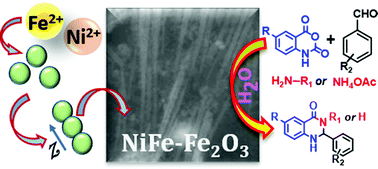In situ fabrication of HDA-mediated NiFe–Fe2O3 nanorods: an efficient and recyclable heterogeneous catalyst for the synthesis of 2,3-dihydroquinazolin-4(1H)-ones in water†
Abstract
A promising strategy for the synthesis of pharmaceutically important scaffold 2,3-dihydroquinazolin-4(1H)-ones through heterogeneous catalysis employing the principle of multicomponent reaction has been presented in this paper. For this purpose, a transition metal comprised catalyst NiFe–Fe2O3 has been designed and developed, where Fe2O3 is formed in situ in the colloidal synthesis of NiFe alloy nanorods at an optimum temperature as confirmed by PXRD, XPS, TEM, HR-TEM, and STEM analysis. For the first time, NiFe alloy-based nanoparticles (NPs) have been synthesized by preparing the nanorod morphology with a mean diameter of 3.57 nm and used in the synthesis of 2,3-dihydroquinazolin-4(1H)-ones. Hexadecylamine (HDA) acts as a capping agent, which directs the chain-like assembly of quantum dot-like particles (3–4 nm) and controls the crystal growth only along the z- direction to finally design the aforementioned material with a specific morphology. These newly fabricated nanoparticles acted as a highly efficient heterogeneous catalysts in the quantitative synthesis of quinazolinones due to their peculiar exposed surfaces, quantum-sized building blocks, large specific surface area, and porosity. The observed high turn-over frequency (TOF) indicates the availability of highly active surfaces in the catalyst. Hence, an efficient and recyclable catalytic protocol operating at optimum temperature conditions with water as the solvent has been proposed.



 Please wait while we load your content...
Please wait while we load your content...